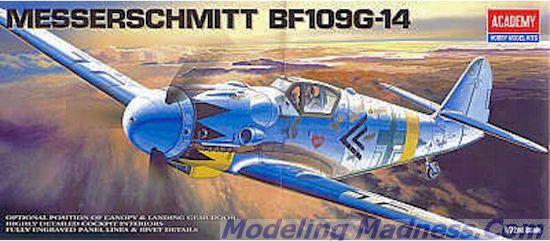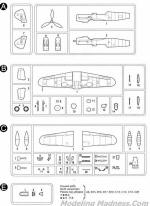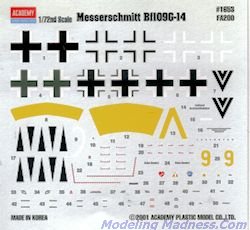
Academy 1/72 Bf-109G-14
| KIT #: | 1653 |
| PRICE: | $6.95 when new |
| DECALS: | Two options |
| REVIEWER: | Scott Van Aken |
| NOTES: | 2001 boxing |

| HISTORY |
The G-14 arrived in July 1944 at the invasion front over France. It represented an attempt to create a standard type, incorporating many changes which had been introduced during production of the G-6, and which led to a plethora of variants, plaguing decentralized mass production. The standardization attempt proved to be a failure, but overall the type offered improved combat performance, as MW 50 power boosting water injection (increasing output to 1,800 PS (1,775 hp, 1,324 kW), the clear-view Erla Haube was now standard installation. Top speed was 568 km/h (353 mph) at sea level, and 665 km/h (413 mph) at 5 km (16,400 ft) altitude. A high-altitude fighter, designated G-14/AS was also produced with the DB 605ASM high-altitude engine. The ASM engine was built with a larger capacity supercharger, and had a higher rated altitude, and correspondingly the top speed of the G-14/AS was 560 km/h (348 mph) at sea level, and 680 km/h (422 mph) at 7,5 km (24,600 ft) altitude. There was increasing tendency to use plywood on some less vital parts e.g. on a taller tailfin/rudder unit, pilot seat or instrument panel. A cautious estimate based on the available records suggest that about 5,500 G-14s and G-14/AS were built.
The following variants of the G-14 were produced:
| THE KIT |
 Not
that many G-14 kits have been produced in 1/72 scale. The earliest is probably
what Heller boxed as a 109K, and more recently, Hasegawa and Fine Molds have
done this version. Academy broke no new ground on this one, choosing to go with
the separate tail section as is often the case with newer 109 kits. This allows
the fuselage to be used for a number of similar variants.
Not
that many G-14 kits have been produced in 1/72 scale. The earliest is probably
what Heller boxed as a 109K, and more recently, Hasegawa and Fine Molds have
done this version. Academy broke no new ground on this one, choosing to go with
the separate tail section as is often the case with newer 109 kits. This allows
the fuselage to be used for a number of similar variants.
For a cockpit, you get a floor with rear bulkhead, some inner fuselage detail along with a separate stick and seat. There are rudder pedal shapes molded on the floor and a box in front of the seat that is supposed to be the cannon breech housing. The kit does provide a separate instrument panel and trim wheels for the fuselage interior.
The upper fuselage breech bulges are separate as is the upper cowling deck itself. Exhaust and their shields are installed from the outside, which I like. Landing gear legs and gear doors are separate as are the one piece main wheels. The kit includes the Morane antenna and aileron mass balances. There is a drop tank rack and the choice of two tank designs. The kit insluces a separate windscreen and canopy. A section of head armor is provided to place inside the Erla Haube canopy. There is no radio mast but there is a DF loop antenna. The prop is a single piece that fits into a two piece spinner/backing plate.
 Instructions
are well done with painting information in generic and RLM color shades.
Markings are provided for two planes. One is the all white box art aircraft with
yellow lower cowling and fuselage band painted in overall white uppers and RLM
76 undersides. This is apparently Erich Hartmann's plane with JG 53 in Feb of
1945 in Hungary. The other is a JG 11 plane from early 1945 in Germany. It is
shown as painted in RLM 74/75/76 with a yellow fuselage band. There is a spiral
for the spinner and a yellow band also covers the very forward nose behind the
spinner. The decal sheet is nicely done, but does not include the swastika.
Instructions
are well done with painting information in generic and RLM color shades.
Markings are provided for two planes. One is the all white box art aircraft with
yellow lower cowling and fuselage band painted in overall white uppers and RLM
76 undersides. This is apparently Erich Hartmann's plane with JG 53 in Feb of
1945 in Hungary. The other is a JG 11 plane from early 1945 in Germany. It is
shown as painted in RLM 74/75/76 with a yellow fuselage band. There is a spiral
for the spinner and a yellow band also covers the very forward nose behind the
spinner. The decal sheet is nicely done, but does not include the swastika.
My kit was sent to me direct from Korea about a dozen years back so still includes the small tube of glue.
| CONCLUSIONS |
I'll leave it to the plans and micrometer crowd to comment on the fidelity of this kit. Needless to say, it looks like it is pretty nice and while not crammed with minute detail, should prove to be a pretty trouble-free build and will add an interesting type to the shelves. I'm not sure about availability, but I'd be surprised if it still wasn't in their current catalogue.
| REFERENCES |
http://en.wikipedia.org/wiki/Messerschmitt_Bf_109_variants
July 2014
Thanks to me for the preview kit.
If you would like your product reviewed fairly and fairly quickly, please contact the editor or see other details in the Note to Contributors.